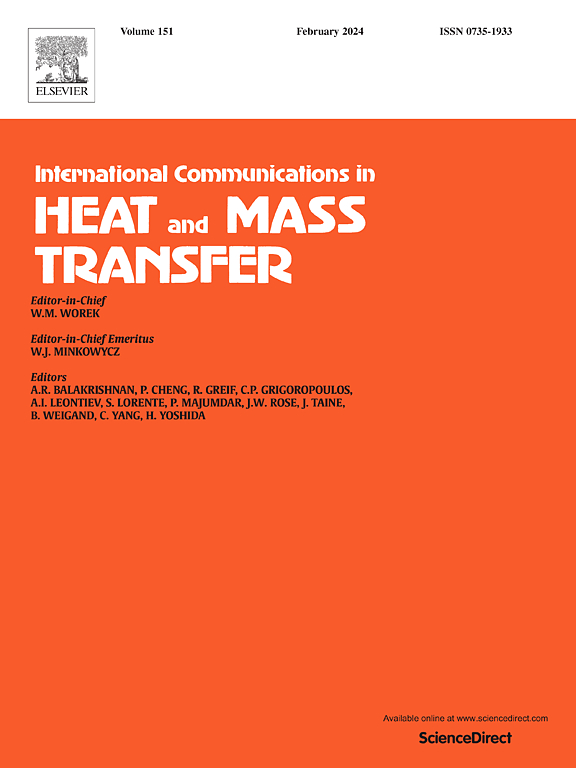平面和狭窄通道中脉动湍流的数值分析
IF 6.4
2区 工程技术
Q1 MECHANICS
International Communications in Heat and Mass Transfer
Pub Date : 2025-07-02
DOI:10.1016/j.icheatmasstransfer.2025.109260
引用次数: 0
摘要
为了评估分离流对脉动换热的影响,对平面通道和狭窄通道的热特性进行了数值研究。该研究在宽脉动频率范围内考察了稳定和脉动的进口流动条件,为分离效应引起的不同行为提供了见解。设湍流雷诺数Reτ = 350。利用OpenFOAM-8中实现的壁面分解LES方法模拟复杂的流动现象。对于平面通道,当ls+ = 4.4时,脉动流动可使换热率提高7.49%,与前人研究结果一致。观察到中心线速度的周期性变化,在中高频率下,近壁流动行为和壁面剪切应力表现出45度的相位滞后。相比之下,在稳定流入条件下,收缩通道的努塞尔数比平面通道增加了40%以上,在ls+ = 4.4时最大增加了19.235%。热性能的改善主要集中在前缘和下游分离区。热增强系数η在狭窄通道中对脉动更为敏感,在ls+ = 3.2 ~ 14时显著增大,而在平面通道中保持稳定。这些发现表明,脉动流,特别是中频,在分离流动的通道中提供了优越的性能,为未来的工程设计提供了有价值的见解。本文章由计算机程序翻译,如有差异,请以英文原文为准。
Numerical analysis of pulsating turbulent flow in planar and constricted channels
To assess the impact of separation flow on pulsating heat transfer, a numerical investigation is conducted to compare the thermal characteristics in both planar and constricted channels. The study examines steady and pulsating inlet flow conditions across a wide range of pulsation frequencies ls+ = 3.2–14, providing insights into the distinct behaviors induced by separation effects. The turbulent Reynolds number Reτ = 350 is set. Wall-resolved LES method implemented in OpenFOAM-8 is used to simulate complex flow phenomena. For the planar channel, pulsating flow enhances heat transfer by up to 7.49 % at ls+ = 4.4, consistent with previous studies. Periodic changes in centerline velocity are observed, showing a 45-degree phase lag in near-wall flow behavior and wall shear stress at medium and high frequencies. In contrast, the constricted channel demonstrates over a 40 % increase in Nusselt number compared to the planar channel under steady inflow, with a maximum enhancement of 19.235 % at ls+ = 4.4. Thermal performance improvement is localized at the leading edge and downstream separation region. The thermal enhancement coefficient η is more sensitive to pulsation in the constricted channel, increasing significantly at ls+ = 3.2–14, while remaining stable in the planar channel. These findings suggest that pulsating flow, particularly at medium frequencies, offers superior performance in channels with separated flow, providing valuable insights for future engineering designs.
求助全文
通过发布文献求助,成功后即可免费获取论文全文。
去求助
来源期刊
CiteScore
11.00
自引率
10.00%
发文量
648
审稿时长
32 days
期刊介绍:
International Communications in Heat and Mass Transfer serves as a world forum for the rapid dissemination of new ideas, new measurement techniques, preliminary findings of ongoing investigations, discussions, and criticisms in the field of heat and mass transfer. Two types of manuscript will be considered for publication: communications (short reports of new work or discussions of work which has already been published) and summaries (abstracts of reports, theses or manuscripts which are too long for publication in full). Together with its companion publication, International Journal of Heat and Mass Transfer, with which it shares the same Board of Editors, this journal is read by research workers and engineers throughout the world.

 求助内容:
求助内容: 应助结果提醒方式:
应助结果提醒方式:


